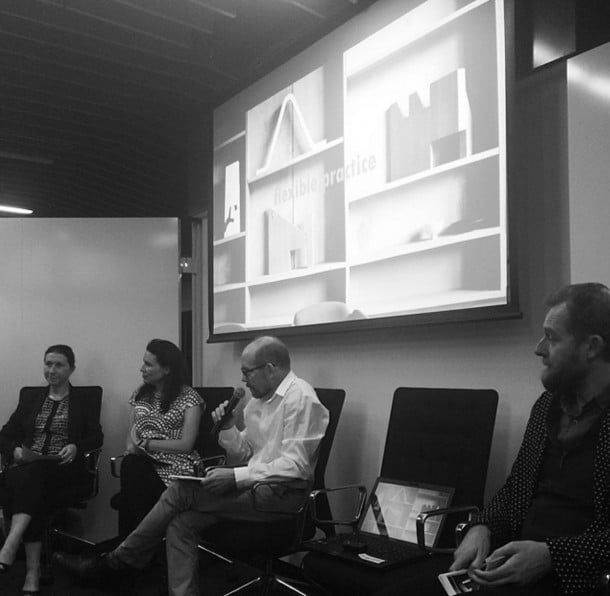The secret is out! Sonia Sarangi reports on How to Flex, a discussion CPD event that demonstrated the advantages of flexible workplaces.
 Architecture is one of the oldest professions in the world and, in certain aspects, practice hasn’t changed in decades. But some practitioners are dismantling one bastion – and are (deservedly) reaping the rewards of their atypical approach.
Architecture is one of the oldest professions in the world and, in certain aspects, practice hasn’t changed in decades. But some practitioners are dismantling one bastion – and are (deservedly) reaping the rewards of their atypical approach.
The secret is out. Part-time architecture staff are Value-for-Money.
The “How to Flex” panel discussion, the first CPD initiative from the Australian Institute of Architects’ National Committee for Gender Equity (NCGE), was a resounding success. It was very well attended, in particular by practice directors/principals, but also by employees wondering how to negotiate such a role.
Chaired by Andrew Broffman, the discussion panel was Misty Waters, Lee Hillam, Patrick Kennedy and Leone Lorrimer.
The evening started with Misty Waters, who gave a fantastic overview from a practice manager’s point of view.
“….most part-time architects work more efficiently and waste less time on Facebook and personal admin than full-time equivalents. It is often more effective to have a slightly more senior person working a three-or-four-day week than it is to have a full-time junior for the same salary.” – Misty Waters, Bespoke Careers
I have witnessed first-hand many principals moaning about the financial strain that staff salaries place on an architecture practice. Sticking to the traditional way of engaging full-time, junior staff and then not assessing their ‘real’ performance for long periods of time is what puts many in this position in the first place.
The maths is pretty simple too.
- Experienced staff member: Full time @ 72k + super
- Same staff member: 3 days a week @43k + super
- Comparable to a graduate at full-time capacity!
However, the experienced staff member will already be much better trained and able to work more efficiently/ independently, as previously mentioned.
Aside from new roles, the fact is that staff turnover is expensive. The time (and hence cost) required to train someone to the level of expertise that they can operate relatively or semi-independently within your practice is substantial. It makes more sense to offer existing staff part-time roles than to decline a request and risk losing them permanently.
The emergence of more part-time roles within architectural practice is fast proving to be a solution for small to medium-sized firms. Particularly now that early adopters like Lee Hillam (from Dunn Hillam in Sydney) and Patrick Kennedy (of Kennedy Nolan in Melbourne) are showing the rich dividends that this approach has given their practices.
“Get staff to put forward their own proposal. Part-time hours change all the time. Accept that. ” – Patrick Kennedy, Kennedy Nolan
A common excuse put forward by many principals is that demanding clients may call on the day the part-time employee is off. Lee Hillam laid that concern to rest in terms of residential clients by pointing out that most are too wrapped up in their own work/life to be calling every day of the week. So long as there are clear processes in place for all staff to take notes or questions from the client for the part-time person while they are away, there are minimal conflicts.
Patrick Kennedy observed that for such processes to work smoothly there needs to be a collegiate office culture, not a rivalry based one. Lee also described the ‘practice float’ available with an office that has part-time roles. This means that when a big project or major deadline suddenly emerges, instead of frantically scrambling for new staff it is easy to have a conversation with staff about temporarily increasing their hours in order to cope with temporary additional workloads.
Leone Lorrimer explained that embracing part-time roles also results in opportunities for larger practices. However, she also noted that some team members may be resistant to change, despite practices having policies that enable flexible working hours. She told an anecdote about a young dad who sought flexibility to work partly from home to be around his newborn child. As he was the first in the all-male team to make such a request, it was not initially supported. The story highlighted how men often appear be excluded from the discussion around flexibility and gender equality, but it is an equally important consideration for them.
We need to rid ourselves of the collective illusion that the flexibility is only an advantage to employees. Employers are also rewarded in many ways when they offer and effectively manage part-time roles.
It is high time we all stopped putting part-time roles into the ‘too-hard’ basket and embrace it as simply good business sense that bolsters the longevity of individual careers as well of practice itself.
This is an edited version of a review first published on the AWS blog.
Sonia Sarangi is co-founder of Atelier Red + Black, an emerging architecture practice in Fitzroy, Victoria. She has previously worked in both small practice (Melbourne) and a large international firm (Singapore). She has a Masters in Architecture from the University of Melbourne. Sonia can be found on Instagram @thesarangi




















